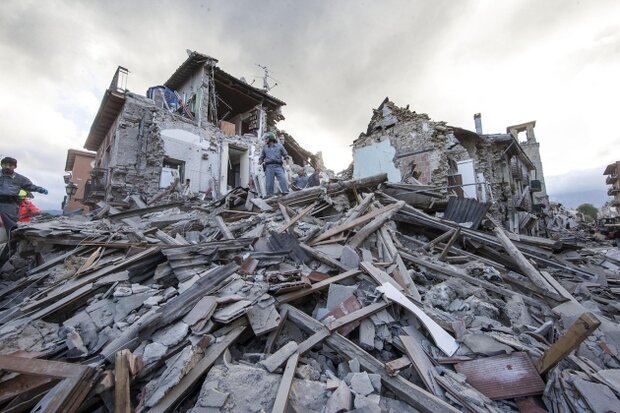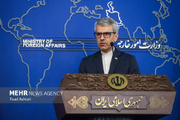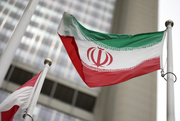The International Day for Disaster Risk Reduction started in 1989, after a call by the United Nations General Assembly for a day to promote a global culture of risk-awareness and disaster reduction.
Held annually on October 13, the day celebrates how people and communities around the world are reducing their exposure to disasters and raising awareness about the importance of reining in the risks that they face.
The 2019 edition continues as part of the "Sendai Seven" campaign, centered on the seven targets of the Sendai Framework. This year will focus on “Substantially reduce disaster damage to critical infrastructure and disruption of basic services, among them health and education facilities, including through developing their resilience by 2030.”
The Sendai Framework is a 15-year voluntary people-centered approach to disaster risk reduction, succeeding the 2005-2015 framework.
Iran also marks the National Disaster Reduction Day on October 13, identifying weaknesses to avoid the potential dangers of these events.
Although in recent years, related bodies are gearing up to provide coordinated support in natural disasters and prevent them from reoccurring, measures taken so far are not responsive to such events and organizations can only meet a very small part of the needs.
To eradicate such shortcomings, long-term measures and practical action plans need to be scaled up while a thorough understanding of the disaster’s scope is required to expand the capacity of national bodies to reduce disaster risk.
In Iran, the occurrences of natural disasters have increased sharply, causing damage and loss to infrastructures and economy, while claiming the lives of many people.
Over the past few years, a series of widespread disasters hit several parts of the country, which challenged risk reduction and management.
Recent floods haunted 28 out of 31 provinces on March 19, a destructive earthquake measuring 7.3 on the Richter scale hit Sarpol-e Zahab in Kermanshah in 2017, and severe sand and dust storms frequently hit the southern provinces. These are some of the major catastrophic disasters over the past decade, which caused devastating and long-term impacts.
In addition to floods, droughts, earthquakes, land subsidence and extreme temperatures, Iran is currently facing a wet spell while dealing with an outbreak of locust swarms that are threatening farmlands.
Actions taken so far to reduce disaster risk
Various laws and regulations have already been adopted to prevent the damage caused by such disasters, including in the Fourth Five-Year National Development Plan (2010-2015) which highlighted fortifying buildings against the force of seismic waves which have been predicted to be ineffective in reducing damage.
Looking closer, the laws only set out the general principles for designing and constructing buildings resilient to earthquake, but neither of these constitutes a guarantee to prevent violations.
Therefore, there should be an organization to oversee these cases, while there is only one which is tasked with rebuilding residential units or areas affected by earthquakes, landslides and floods.
Apart from identifying the reason behind disaster reduction laws failure and funds spent in this regard, more efficient crisis management solutions must be discovered, including using world experiences in preventing natural disasters.
To do so, the establishment of a national disaster risk reduction strategy can help the country focus on how to reduce disaster risks and set priorities for action.
Therefore, conducting researches on how to make cities resilient to natural disasters will find the best policies while the most efficient and cost-effective methods and technologies.
What is the main factor in disaster management?
Disaster management is a cycle consisting of mitigation, preparedness, response and ended with recovery; the most neglected among which is preparedness in the country.
However, the response cycle is the most experienced part, with preparedness effectiveness and efficiency of response will increase.
Generally, crisis planning needs sufficient information from databases, but Iran suffers from lack of access to great databases like spatial database information and Geographic Database Information and communication among organizations to interchange information.
Another problem is lack of an organization to compensate for the destruction, as insurance plays a main role in risk transfer and funds for rebuilding.
Finally, preparedness of people for emergency situations is a vital factor which needs appropriate public education in self-protecting behaviors, relief aids, mitigation etc. and Iran has not done much to improve effectiveness except for some maneuvers and limited educations.
Having even sufficient knowledge of how to prepare for emergencies does not guarantee that people would take self?protection measures, so past disaster experience is not the prime factor to enhance awareness or even maneuvers and school education cannot rationally provide useful information as a knowledge base for earthquakes.
History of a common natural disaster
The first law in Iran on flood hazards and damages was enacted as the law on prevention and tackling flood hazards in 1969, which was passed to protect people's lives and property from destructive floods, and the Ministry of Interior was required to take all necessary measures to preserve, correct and rebuild floodwaters and drainage.
Ministries and government agencies were required to provide the Ministry of the Interior with all the facilities to confront flood threat and other natural disasters throughout the country.
A few years later, another bill was passed by the parliament to form a national committee to reduce the impact of natural disasters.
The purpose of this law was to exchange information, study, conduct scientific research and find reasonable solutions to prevent and mitigate the effects of natural disasters caused by storms, floods, droughts, etc.
Of course, the laws faced failure due to the weaknesses in its implementation, the Central Insurance Company has introduced a bill establishing a natural disaster insurance fund aimed at helping natural disaster victims and enhancing their ability to recover.
With the anticipation of damage and reducing the government's financial burden to compensate for damage, it was approved by the Cabinet in 2001 but still awaiting implementation due to lack of budget.
Now, being affected by climate change, rainfall fluctuations have resulted in numerous flood events in the country which have been said to be tackled with dam construction.
“Preventing the construction in the river beds and banks play an important role in flood control; in addition, structures such as bridges built on rivers should be of sufficient strength, although in many areas small dams in flood-prone areas can be of great help,” said Energy Minister Reza Ardakanian.
Due to the belief claiming that dams are solutions to flooding, currently, 109 dams are under construction in the country, 43 of which are for drinking purposes.
This is while, with the deterioration of the country's poor water resources in recent years, different approaches to dam construction have been developed and dam construction has been contained to some extent.
The recent floods and its dire consequences, especially in Mazandaran, Golestan and Fars provinces, showed that neglecting 'prevention' can cause irreparable damage to the country.
Multiple floods in the country caused millions of cubic meters of water to flow into the areas aimlessly, which experts believe could be used in agriculture sector by advanced technology.
A manmade high impact disaster
Forests are the other natural resources which are potentially vulnerable to threats posed by hazards especially those caused by human.
Less protection of forests also can intensify natural disasters impact like lack of vegetation cover that can considerably increase the flood devastation.
Vegetation depletion can be caused whether by deforestation or wildfire.
Qasem Sabz’ali, commander of the forest protection unit of the Forests, Range, and Watershed Management Organization, said in April 2018 that some 15,000 hectares of forests burn in wildfires annually in Iran that 95 percent of them are caused by humans, ISNA reported.
Forest wildfire brings heavy economic burden amounting to 560 million rials (about $13,000) per hectare for the country, he added.
It should be possible to set up independent firefighting system in forests and rangelands in order to function properly when fire strike, and to have the ability to control fire in natural environments. It is also possible by training specialized forces.
What is the main challenge?
Two catastrophic events, one said to be caused by human, the other by nature, have been discussed, both of which rooted in human actions, namely, poor policies, lack of law enforcement, environmental degradation, lack of consideration by officials or people.
The lack of regulatory frameworks, unplanned urbanization and development of cities, lack of efficient environmental plans and policies, old buildings and at risk infrastructure, inadequate capacities of municipalities, lack of funding and qualified human resources, are among the major challenges in creating disaster resilient cities in Iran, as well.
To overcome it, responsible bodies should be better equipped to understand their disaster risk landscape, also better positioned to enhance their early warning system, plans and laws should be prepared, and the communities should be better alert in advance of a potential disaster, to reduce future losses.
MNA/TT

























Your Comment